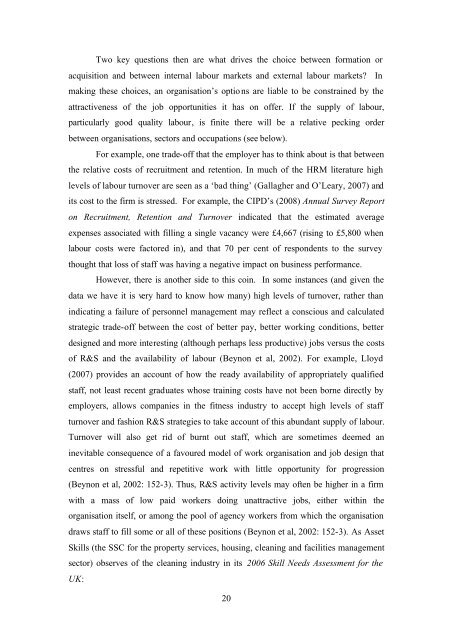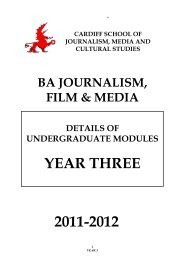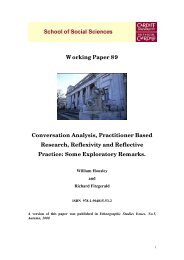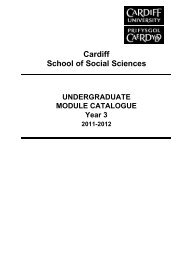Recruitment and Selection â the Great Neglected ... - Cardiff University
Recruitment and Selection â the Great Neglected ... - Cardiff University
Recruitment and Selection â the Great Neglected ... - Cardiff University
Create successful ePaper yourself
Turn your PDF publications into a flip-book with our unique Google optimized e-Paper software.
Two key questions <strong>the</strong>n are what drives <strong>the</strong> choice between formation or<br />
acquisition <strong>and</strong> between internal labour markets <strong>and</strong> external labour markets? In<br />
making <strong>the</strong>se choices, an organisation’s options are liable to be constrained by <strong>the</strong><br />
attractiveness of <strong>the</strong> job opportunities it has on offer. If <strong>the</strong> supply of labour,<br />
particularly good quality labour, is finite <strong>the</strong>re will be a relative pecking order<br />
between organisations, sectors <strong>and</strong> occupations (see below).<br />
For example, one trade-off that <strong>the</strong> employer has to think about is that between<br />
<strong>the</strong> relative costs of recruitment <strong>and</strong> retention. In much of <strong>the</strong> HRM literature high<br />
levels of labour turnover are seen as a ‘bad thing’ (Gallagher <strong>and</strong> O’Leary, 2007) <strong>and</strong><br />
its cost to <strong>the</strong> firm is stressed. For example, <strong>the</strong> CIPD’s (2008) Annual Survey Report<br />
on <strong>Recruitment</strong>, Retention <strong>and</strong> Turnover indicated that <strong>the</strong> estimated average<br />
expenses associated with filling a single vacancy were £4,667 (rising to £5,800 when<br />
labour costs were factored in), <strong>and</strong> that 70 per cent of respondents to <strong>the</strong> survey<br />
thought that loss of staff was having a negative impact on business performance.<br />
However, <strong>the</strong>re is ano<strong>the</strong>r side to this coin. In some instances (<strong>and</strong> given <strong>the</strong><br />
data we have it is very hard to know how many) high levels of turnover, ra<strong>the</strong>r than<br />
indicating a failure of personnel management may reflect a conscious <strong>and</strong> calculated<br />
strategic trade-off between <strong>the</strong> cost of better pay, better working conditions, better<br />
designed <strong>and</strong> more interesting (although perhaps less productive) jobs versus <strong>the</strong> costs<br />
of R&S <strong>and</strong> <strong>the</strong> availability of labour (Beynon et al, 2002). For example, Lloyd<br />
(2007) provides an account of how <strong>the</strong> ready availability of appropriately qualified<br />
staff, not least recent graduates whose training costs have not been borne directly by<br />
employers, allows companies in <strong>the</strong> fitness industry to accept high levels of staff<br />
turnover <strong>and</strong> fashion R&S strategies to take account of this abundant supply of labour.<br />
Turnover will also get rid of burnt out staff, which are sometimes deemed an<br />
inevitable consequence of a favoured model of work organisation <strong>and</strong> job design that<br />
centres on stressful <strong>and</strong> repetitive work with little opportunity for progression<br />
(Beynon et al, 2002: 152-3). Thus, R&S activity levels may often be higher in a firm<br />
with a mass of low paid workers doing unattractive jobs, ei<strong>the</strong>r within <strong>the</strong><br />
organisation itself, or among <strong>the</strong> pool of agency workers from which <strong>the</strong> organisation<br />
draws staff to fill some or all of <strong>the</strong>se positions (Beynon et al, 2002: 152-3). As Asset<br />
Skills (<strong>the</strong> SSC for <strong>the</strong> property services, housing, cleaning <strong>and</strong> facilities management<br />
sector) observes of <strong>the</strong> cleaning industry in its 2006 Skill Needs Assessment for <strong>the</strong><br />
UK:<br />
20
















